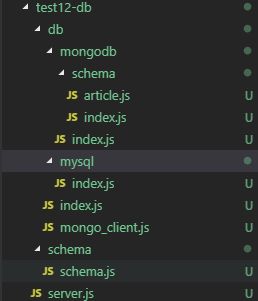GraphQL学习与实践5(连接数据库mongodb与mysql)
GraphQL学习与实践5(连接数据库mongodb与mysql)
- mongodb
- mysql
- 更多
接口最终还是得持久化物理容器中做增删改查的操作。
新建一下图片的目录,test12-db:

mongodb
通常链接mongodb,我们使用mongoose模块来处理:
npm install --save mongoose
然后在db目录中封装了一个获取数据库链接对象的类MongoClient:
const mongoose = require('mongoose');
module.exports = class MongoClient {
constructor({ uri, options, schemas } = {}) {
this.schemas = schemas;
this.uri = uri;
this.options = options;
this.models = {};
this.connection = null;
}
async connect() {
let { uri, options } = this;
mongoose.set('useCreateIndex', true);
mongoose.set('bufferCommands', false);
mongoose.set('bufferMaxEntries', 0);
mongoose.set('autoIndex', false);
mongoose.connection.on('error', function () {
console.error('connection error: uri is %s,options is %s', uri, JSON.stringify(options));
});
mongoose.connection.once('open', function () {
console.info('connection success', uri);
});
let connection = await mongoose.createConnection(uri, options);
this.connection = connection;
console.info('Init mongoose success');
return connection;
}
getCollection(key) {
if (this.schemas[key]) {
if (this.models[key]) {
return this.models[key];
}
let model = this.connection.model(key, this.schemas[key]);
this.models[key] = model;
return model;
}
throw new Error("illegal key");
}
}
在MongoClient中提供一个connect的方法返回链接对象,以面对多重链接的情况,同时提供getCollection提供给没有model首次链接的时候再获取链接对象,这种情况一般用于serverless的lambda函数,这里就直接拿着之前的封装直接来用了。
然后在mongodb目录下再提供了一个对象的index.js:
const MongoClient = require("../mongo_client");
const schemas = require("./schema");
const [uri, options] = [
"mongodb://127.0.0.1:27017/onsen",
{
useNewUrlParser: true,
useCreateIndex: true,
},
]
const client = new MongoClient({ uri: uri, options: options, schemas: schemas });
module.exports = client;
注:这里的数据库,就需要自己去创建模拟数据了。
在根目录的server.js文件中,创建graphql的服务:
const express = require('express');
const cors = require('cors')
const graphqlHTTP = require('express-graphql');
const graphql = require('graphql');
const { queryType } = require("./schema/schema");
require("./db").mongodb.connect();
const schema = new graphql.GraphQLSchema({ query: queryType });
const app = express();
app.use(cors());
app.use('/graphql', graphqlHTTP({
schema: schema,
graphiql: true,
}));
app.listen(4000);
console.log('Running a GraphQL API server at localhost:4000/graphql');
相比之前的代码,可以看到增加了:
require("./db").mongodb.connect();
mysql
安装mysql的模块:
npm install --save mysql
同样的类似于mongodb的封装一样,这里也封装了一个mysql的客户对象:
var mysql = require('mysql');
class MysqlClient {
constructor(options = {}) {
this.pool = mysql.createPool(options);
}
doQuery(query) {
return new Promise((resolve, reject) => {
this.pool.getConnection((err, conn) => {
if (err) {
return reject(err);
}
console.info('getConnection ok')
conn.query(query, (err, results, fields) => {
conn.release();
if (err) {
return reject(err);
}
return resolve(results || null);
})
})
});
}
}
const options = {
connectionLimit: 1000,
host: '127.0.0.1',
password: 'password',
database: 'yiibaidb',
user: 'root',
}
module.exports = new MysqlClient(options);
具体有关mysql模块的,见:
https://www.npmjs.com/package/mysql
做好了数据库的引用,然后就可以像前面一样,直接使用schema中写业务逻辑了,见schema.js:
const graphql = require('graphql');
const mongodb = require("../db").mongodb;
const mysql = require("../db").mysql;
const ArticleType = new graphql.GraphQLObjectType({
name: 'Article',
fields: {
_id: {
type: graphql.GraphQLString
},
title: {
type: graphql.GraphQLString
},
source: {
type: graphql.GraphQLString
},
}
});
const OrderType = new graphql.GraphQLObjectType({
name: 'Order',
fields: {
orderNumber: {
type: graphql.GraphQLInt
},
status: {
type: graphql.GraphQLString
},
comments: {
type: graphql.GraphQLString
},
}
});
const queryType = new graphql.GraphQLObjectType({
name: 'Query',
fields: {
articles: {
type: graphql.GraphQLList(ArticleType),
resolve: async () => await mongodb.getCollection('Article').find({}),
},
orders: {
type: graphql.GraphQLList(OrderType),
args: {
page: {
type: graphql.GraphQLInt
},
pageSize: {
type: graphql.GraphQLInt
},
},
resolve: async (_, { page = 0, pageSize = 10 }) => await mysql.doQuery(`
SELECT * FROM orders limit ${((page - 1) < 0 ? 0 : (page - 1)) * pageSize},${pageSize};
`),
}
}
});
module.exports = { queryType };
这里的业务提供了articles和orders的两个查询,分别用的是mongodb和mysql的数据库操作。
在工具上进行验证,输入:
{
articles{
_id,
title,
source,
},
orders(page:1,pageSize:5){
orderNumber,
status,
comments,
}
}
更多
[GraphQL学习与实践1(入门介绍)](http
s://blog.csdn.net/onsenOnly/artic
le/details/102639327)
GraphQL学习与实践2(类型、传参与构造函数类型)
GraphQL学习与实践3(Mutations And Input Types)
GraphQL学习与实践4(模拟客户端请求)
GraphQL学习与实践5(连接数据库mongodb与mysql)
代码:
onsenOnly:https://github.com/onsenOnly/graphql-test
有缘请点颗星,谢谢!
